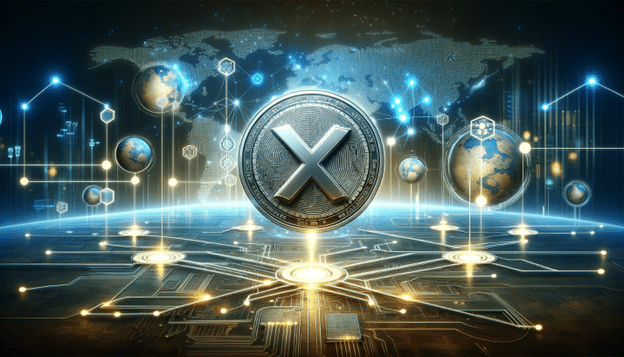If you’re interested in everything crypto, you’ve come to the right place – The Crypto Basic is not only a major outlet taking you through the latest developments in crypto news, but also a top-tier source via which you can easily understand such matters as the technology behind cryptocurrencies.
XRP, for instance, is a standout in the world of digital assets, offering a glimpse into the future of blockchain and its potential impact on various industries.
As such, this article seeks to delve into the technology that powers XRP, its diverse applications, and its trajectory for the foreseeable future; we’ll also explore how XRP’s speed, cost-effectiveness, scalability, and sustainability are setting new standards in the crypto world and beyond.
What is the Technology Behind XRP?
XRP, the digital asset of the Ripple network, is a groundbreaking example of blockchain innovation; launched in 2012, it has set itself apart in the cryptocurrency domain with its unique features:
1. Fast and Efficient Transactions
XRP is renowned for its incredible speed, settling transactions in just 3-5 seconds; this is a stark contrast to other cryptocurrencies, which can take longer to process the same operations.
The low average transaction fee of $0.0002 also adds to its appeal.
2. Scalability and Stability
The XRP Ledger can process 3,400 transactions per second, dwarfing many competitors in scalability.
– Advertisement –
This high throughput is coupled with impressive stability, with over 80 million closed ledgers since 2012.
3. Environmental Sustainability
In a time when the energy consumption of cryptocurrencies is under scrutiny, XRP stands out for its sustainability – it is 61,000 times more energy-efficient than traditional proof-of-work blockchains, making it a more environmentally friendly option.
4. Decentralized and Distributed Network
The XRP Ledger is decentralized and supported by a global network of over 100 validators; this distributed nature ensures security and resilience against attacks.
How Is It Used?
XRP’s practical applications are as diverse as its technology is innovative:
1. Transforming Cross-Border Payments
XRP revolutionizes the way cross-border payments are made: by providing a bridge for currency conversion, it ensures that payments are swiftly sent and received in local currencies on either side of a transaction.
This greatly reduces the transaction time and costs associated with international payments.
2. Smart Contracts and Decentralized Applications
Although Ripple’s own smart contract platform is on hold, the XRP community and developers are actively integrating smart contract functionalities into the XRP Ledger, allowing for the creation of self-executing contracts and decentralized applications (DApps), which are applications that run on a peer-to-peer network rather than centralized servers.
These applications range from payment and remittance platforms to gaming, virtual goods trading, and decentralized exchanges.
3. Advancing Supply Chain Management
By leveraging XRP technology, businesses can create transparent and efficient supply chain solutions; this application is particularly crucial for industries requiring high levels of traceability, such as food, pharmaceuticals, and luxury goods.
The blockchain’s immutable nature ensures an accurate and secure record of all transactions, movements, and certifications.
How Will the Tech Behind XRP Evolve?
1. Embracing Parallel Processing for Enhanced Scalability
Ripple’s technology architecture allows for parallel processing, enabling the simultaneous execution of multiple transactions; this not only enhances scalability but also maintains high performance, even during high-volume periods.
This feature ensures that Ripple can cater to both individual and large-scale business transaction needs.
2. Continual Improvement in Consensus Mechanism
The Ripple Protocol Consensus Algorithm (RPCA) is a unique consensus mechanism that enables fast, efficient transaction processing; unlike proof-of-work or proof-of-stake mechanisms, the RPCA achieves consensus among validating nodes on the order and outcome of transactions.
This innovative approach results in faster transaction processing and higher throughput, capable of handling numerous transactions per second.
3. Expanding into New Industries
XRP’s potential extends beyond the banking and financial sectors – it is making strides in niche markets such as financial inclusion for the unbanked, gaming ecosystems, asset tokenization, and even in the realms of supply chain management and asset tracking.
This diversification illustrates XRP’s adaptability and potential to revolutionize various industries.
In Conclusion
XRP’s technology is not just a foundation for a digital asset – it’s a beacon of innovation in the blockchain space.
With its rapid transaction speeds, low costs, scalability, sustainability, and a decentralized network, XRP is well-positioned to continue its growth in the cryptocurrency market.
As the technology evolves, its applications are set to expand, potentially reshaping industries beyond finance.
Stay tuned to The Crypto Basic for more in-depth insights and XRP news, as we strive to keep you informed in this dynamic and exciting field.
Follow Us on Twitter and Facebook.
Disclaimer: This content is informational and should not be considered financial advice. The views expressed in this article may include the author’s personal opinions and do not reflect The Crypto Basic’s opinion. Readers are encouraged to do thorough research before making any investment decisions. The Crypto Basic is not responsible for any financial losses.
-Advertisement-
This article was originally published by a thecryptobasic.com . Read the Original article here. .

